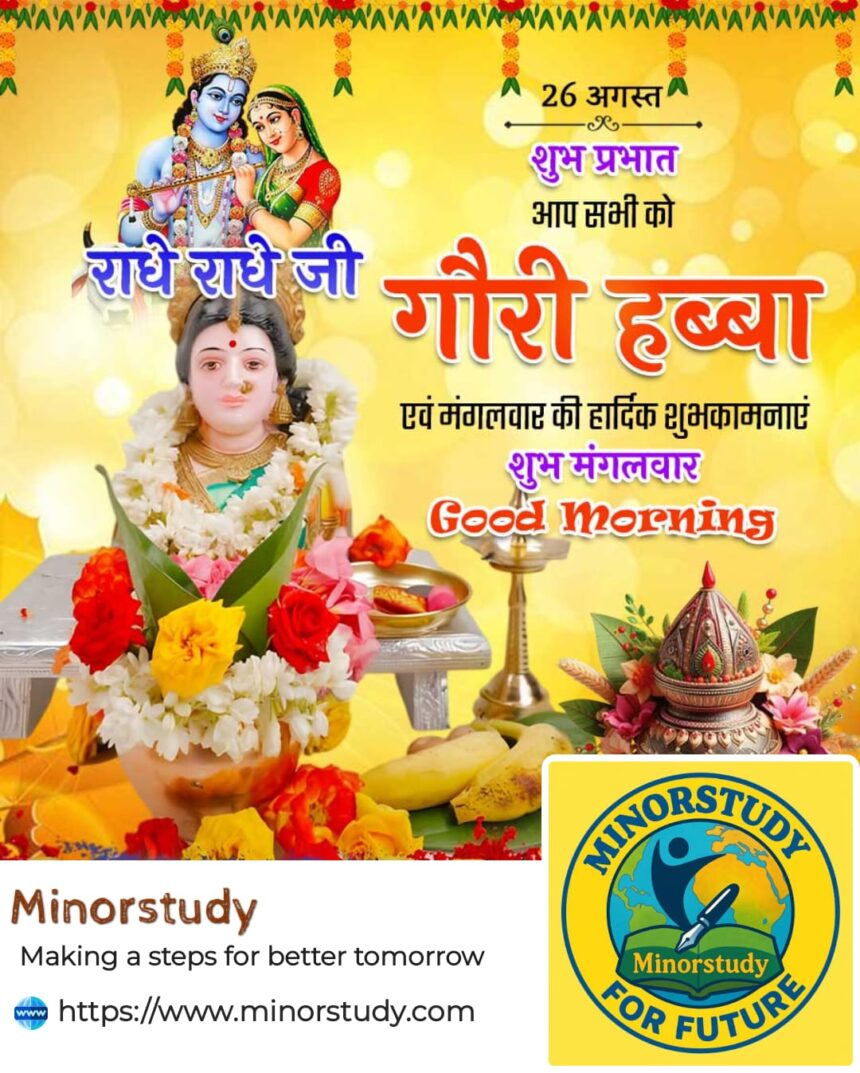🌼 9 Wonderful Reasons Why Gauri Habba is a Joyful Festival of Devotion and Prosperity
Introduction
India is blessed with countless festivals that beautifully blend devotion, culture, and family values. One such unique festival is Gauri Habba, also known as Swarna Gouri Vratam, celebrated predominantly in Karnataka, Andhra Pradesh, and Tamil Nadu. Dedicated to Goddess Gauri (an incarnation of Parvati), this festival honors her strength, purity, and power to remove obstacles.
- Introduction
- 📜 History of Gauri Habba
- 📅 Timeline of Gauri Habba
- 🌟 Key Facts about Gauri Habba
- 🙏 Significance of Gauri Habba
- 🎉 Observance and Rituals of Gauri Habba
- 💐 Wishing on Gauri Habba
- 🌍 Importance in Our Life and Society
- 📌 Important Points about Gauri Habba
- ❓ FAQs about Gauri Habba
- 🌟 Conclusion – Daily Life Impacts of Gauri Habba
Women, both married and unmarried, celebrate Gauri Habba with devotion, fasting, and rituals to seek blessings for a happy married life, prosperity, and peace at home. What makes it special is that it is celebrated a day before Ganesh Chaturthi, marking the divine arrival of Gauri, followed by her son Lord Ganesha.
Let us dive deep into the history, facts, rituals, significance, timeline, FAQs, wishes, and daily life impacts of this beautiful festival.
📜 History of Gauri Habba
The story of Gauri Habba is deeply rooted in Hindu mythology. According to legends:
Goddess Gauri, wife of Lord Shiva and mother of Lord Ganesha, represents purity, fertility, and abundance.
It is believed that Gauri comes to her parental home on this day and returns with Ganesha the next day, symbolizing motherly love and divine blessings.
Another story says that Goddess Parvati, as Gauri, performed intense penance to marry Lord Shiva, symbolizing devotion and willpower.
Historically, this festival has been observed in Karnataka and South India for centuries, with households welcoming Goddess Gauri in decorated kalashas (sacred pots) and worshipping her with flowers, fruits, and special dishes.
Thus, Gauri Habba is not just a ritual but also a celebration of womanhood, prosperity, and family bonds.
📅 Timeline of Gauri Habba
Vedic Times – References of Parvati’s devotion and Gauri’s significance in scriptures.
Early South Indian Dynasties – Gauri worship linked with harvest, prosperity, and family happiness.
Medieval Era – Royal households celebrated Gauri Habba with grandeur, involving community gatherings and feasts.
Modern Times – Observed with traditional rituals at home, alongside eco-friendly awareness and community-based celebrations.
🌟 Key Facts about Gauri Habba
Date of Celebration – On the third day of Bhadrapada month (usually a day before Ganesh Chaturthi).
Deity Worshipped – Goddess Gauri (Parvati).
Geographical Popularity – Mainly in Karnataka, Andhra Pradesh, and Tamil Nadu.
Main Ritual – Women install a decorated kalasha or idol of Goddess Gauri.
Fasting Tradition – Women observe vrat (fast) for the well-being of their family.
Symbolism – Represents prosperity, fertility, purity, and family happiness.
Special Food – Offerings include puliyogare (tamarind rice), kosambari (salad), payasa (sweet dish), and laddus.
Connection with Ganesh Chaturthi – Gauri’s arrival marks the beginning of festive joy, followed by Ganesha’s arrival the next day.
Spiritual Significance – A day of invoking Shakti (divine feminine energy) for harmony and protection.
🙏 Significance of Gauri Habba
The festival holds multiple layers of significance:
For Women – Married women pray for the long life and prosperity of their husbands, while unmarried girls seek blessings for a good husband.
For Families – Strengthens unity, prosperity, and peace in households.
For Society – Promotes the value of devotion, discipline, and respect for women’s spiritual power.
For Spirituality – Symbolizes purity, penance, and divine strength, teaching the importance of faith and perseverance.
🎉 Observance and Rituals of Gauri Habba
The festival is celebrated with enthusiasm and traditional beauty. The key observances include:
Pre-Dawn Preparations – Women wake up early, bathe, and clean their homes.
Kalasha Installation – A kalasha (pot) filled with water, betel leaves, turmeric, and rice is decorated with flowers and mango leaves. A coconut smeared with turmeric is placed on top, symbolizing Goddess Gauri.
Alankara (Decoration) – Idols or pictures of Goddess Gauri are decorated with sarees, ornaments, and flowers.
Puja Rituals – Women perform puja with kumkum, turmeric, flowers, fruits, and sacred items.
Fasting – A fast is observed till evening; later, prasadam (offering) is shared among family members.
Exchange of Gifts – Married women exchange baagina (a set of turmeric, kumkum, bangles, fruits, and flowers) with relatives and friends.
Special Food Preparation – Traditional delicacies like puliyogare, payasa, holige, and kosambari are prepared.
Community Celebrations – In some regions, women gather in groups to sing devotional songs and share prasad.
💐 Wishing on Gauri Habba
Some heartfelt wishes to share:
🌸 “May Goddess Gauri bless your family with happiness, prosperity, and good fortune. Happy Gauri Habba!”
🌸 “On this Gauri Habba, may your home be filled with divine blessings, harmony, and joy.”
🌸 “Wishing you a blissful Gauri Habba filled with devotion, purity, and prosperity.”
🌍 Importance in Our Life and Society
Gauri Habba is not only about rituals; it impacts daily life in meaningful ways:
Promotes Family Values – Teaches the importance of unity, love, and respect within families.
Empowers Women – Highlights women’s role as nurturers, protectors, and spiritual pillars of society.
Encourages Devotion and Discipline – Through fasting and rituals, individuals practice patience and inner strength.
Cultural Preservation – Keeps alive South Indian traditions, food, folk songs, and rituals.
Community Bonding – Women exchange gifts, strengthening social relationships and sisterhood.
Symbol of Prosperity – Encourages gratitude for abundance and blessings in life.
📌 Important Points about Gauri Habba
Celebrated a day before Ganesh Chaturthi.
Involves worship of kalasha symbolizing Goddess Gauri.
Women exchange baagina as part of the rituals.
Prayers focus on marital happiness, family prosperity, and peace.
Goddess Gauri is seen as the bringer of wealth and remover of obstacles.
❓ FAQs about Gauri Habba
Q1. When is Gauri Habba celebrated?
👉 On the third day of Bhadrapada month, a day before Ganesh Chaturthi.
Q2. What is the main ritual of Gauri Habba?
👉 Installation of a kalasha symbolizing Goddess Gauri, along with puja and fasting.
Q3. Who celebrates Gauri Habba?
👉 Mainly women in Karnataka, Andhra Pradesh, and Tamil Nadu.
Q4. What food is prepared during Gauri Habba?
👉 Puliyogare, kosambari, holige, payasa, and laddus are popular.
Q5. Why is Gauri Habba connected with Ganesh Chaturthi?
👉 Because Gauri arrives a day before Ganesha, symbolizing motherly love and divine blessings.
🌟 Conclusion – Daily Life Impacts of Gauri Habba
Gauri Habba is more than a religious festival; it is a celebration of life, devotion, and family harmony. It reminds us of the power of purity, patience, and perseverance that Goddess Gauri represents.
In daily life, it inspires women to stay strong, devoted, and spiritually connected.
It strengthens family bonds and ensures cultural values are passed on to younger generations.
It creates a sense of gratitude, reminding us to celebrate abundance and seek divine blessings for peace.
In society, it fosters unity, respect for traditions, and an appreciation of women’s role in shaping families and communities.
In essence, Gauri Habba teaches us that true prosperity lies not only in material wealth but in spiritual growth, harmony, and love within families.








